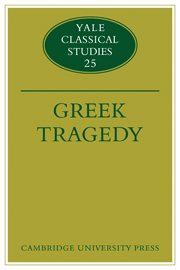Book contents
- Frontmatter
- Contents
- Introduction
- Septem contra Thebas
- The dissembling-speech of Ajax
- The tragic issue in Sophocles' Ajax
- Sophocles' Trachiniae: myth, poetry, and heroic values
- On ‘extra-dramatic’ communication of characters in Euripides
- The infanticide in Euripides' Medea
- The Medea of Euripides
- On the Heraclidae of Euripides
- Euripides' Hippolytus, or virtue rewarded
- Euripides' Heracles
- The first stasimon of Euripides' Electra
- Trojan Women and the Ganymede Ode
- The Rhesus and related matters
Sophocles' Trachiniae: myth, poetry, and heroic values
Published online by Cambridge University Press: 10 January 2011
- Frontmatter
- Contents
- Introduction
- Septem contra Thebas
- The dissembling-speech of Ajax
- The tragic issue in Sophocles' Ajax
- Sophocles' Trachiniae: myth, poetry, and heroic values
- On ‘extra-dramatic’ communication of characters in Euripides
- The infanticide in Euripides' Medea
- The Medea of Euripides
- On the Heraclidae of Euripides
- Euripides' Hippolytus, or virtue rewarded
- Euripides' Heracles
- The first stasimon of Euripides' Electra
- Trojan Women and the Ganymede Ode
- The Rhesus and related matters
Summary
The monstrous river-god Achelous wooing a tender maiden and defeated amid the crash of fist and horn; the ‘beast-man’ killed in the river; the poisonous blood of the Centaur mingled with the venom of the Hydra; the tuft of wool flaring up and crumbling ominously in the sunlight; the hideous sufferings of the great hero Heracles as the venom, heated by the sacrificial fires and his own sweat as he slaughters bulls, seeps into his flesh – this is the mythical stuff of which Sophocles made his Trachiniae. These elements are not merely pieces of decorative vignettes or ‘sensational tableaux’. They are essential elements in one of the boldest and most powerful creations of Greek dramatic poetry. And yet the failure to take these mythical elements and the imagery which surrounds them at full seriousness has led to misunderstanding and undervaluation of this great play.
No other extant Sophoclean play makes use of such intractable mythical material and faces such a gulf between the characters as human beings and the characters as symbolic figures. This gulf creates much of the difficulty of modern response to the play. Sophocles draws Deianeira's domestic tragedy with the fullness and naturalism appropriate to the developed sensibilities of the civilized realm where she belongs, whereas Heracles never emerges entirely from the remote mythology and from the ancient powers of nature which he vanquishes.
- Type
- Chapter
- Information
- Greek Tragedy , pp. 99 - 158Publisher: Cambridge University PressPrint publication year: 1977



